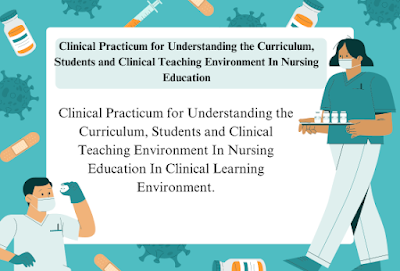The Clinical Practicum for Understanding the Curriculum Students and Clinical Teaching Environment In Nursing Education. For nursing specializations, this is called a clinical internship. A clinical internship is a supervised, on-site experience where you develop applied skills and integrate specialized knowledge into nursing practice.
The Clinical Practicum for Understanding the Curriculum Students and Clinical Teaching Environment In Nursing Education
A clinical internship is a supervised, on-site experience where nursing students develop applied skills and integrate specialized knowledge into patient care. It is an important component of nursing education and helps students translate theoretical knowledge into practical skills in a real-life setting. The goal of the internship is to help students gain experience in the clinical setting, better understand the curriculum, and hone their professional skills.
Clinical learning environments (CLEs) are essentially any location where students (and other students) learn about patient care, from the bedside to the equipment room, from the emergency room to the operating room, the clinic, and the hospital wards.
Understanding the Curriculum in Nursing Education
Clinical Practicum for Understanding the Curriculum The nursing curriculum serves as a carefully structured framework guiding the selection of learning experiences and clinical assignments. It helps in organizing teaching and learning activities and measuring student performance. By building on prior knowledge and reinforcing its application, the curriculum fosters a logical progression of student learning experiences.
However, this structured approach does not limit faculty members from employing creative and innovative methods in clinical settings. In fact, incorporating creative techniques can significantly enhance student motivation and knowledge retention, preparing them for practical application in real-world scenarios.
Research consistently highlights that both clinical instructors and students find a comprehensive understanding of the curriculum to be a critical factor in effective clinical instruction (Bisholt et al., 2014; Dahlke et al., 2012; Wyte Lake et al., 2013). As students move through various practicum experiences, it becomes the faculty’s responsibility to align these experiences with the course competencies, fostering a clear connection between theory and practice.
Understanding the Student in Clinical Settings
Clinical practicum provides students with the essential opportunity to apply both the art and science of nursing, enhancing their ability to integrate theoretical knowledge into practical scenarios. To optimize these experiences, faculty members must have a deep understanding of each student’s unique background, needs, and learning preferences.
Today’s nursing students are a diverse group, representing different age ranges, ethnicities, and gender demographics. Many come with prior degrees in other fields or possess healthcare-related experience and varying levels of technological proficiency. This diversity in knowledge, skills, and learning styles demands that faculty members adapt their teaching strategies accordingly, ensuring that all students meet curriculum objectives and expected competencies.
Faculty should regularly assess students’ knowledge, skills, and cultural backgrounds to determine whether they possess the cognitive, critical thinking, and decision-making abilities necessary for successful clinical experiences. These assessments help tailor clinical placements to maximize student growth while aligning with curriculum outcomes.
Understanding the Clinical Environment in Nursing Education
The clinical learning environment (CLE) serves as the setting where students synthesize classroom knowledge and apply it in real-world clinical situations. According to Chan (2002), the CLE is defined as “the interaction network of forces within the clinical setting that influences student learning outcomes.”
Several factors affect these learning outcomes, such as the availability of clinical staff for supervision, the extent of student-centered teaching, and the opportunities provided for individualized learning (Newton et al., 2012). A positive clinical environment values innovation, creativity, and flexible work practices, all of which enhance student learning and integration into the professional world.
Students often face heightened anxiety in clinical settings due to the challenges of combining critical thinking with practical skills. A supportive clinical environment, characterized by thorough orientation, adequate preparation, and encouragement of creative problem-solving, can help reduce student anxiety and promote a positive learning experience (Ganley & Linnard-Palmer, 2010). Faculty play a vital role in creating such environments, ensuring that students are not only prepared to meet operational demands but also equipped to achieve daily learning goals.
Selecting Clinical Practicum Experiences in Nursing Education
Clinical practicum experiences are central to nursing education, as they provide students with essential opportunities to apply theoretical knowledge, develop clinical skills, and undergo professional socialization. These experiences should span various clinical settings and patient populations to give students a well-rounded view of nursing practice, with a particular emphasis on health promotion and disease prevention.
The selection and planning of practicum experiences require faculty members to possess a deep understanding of both the curriculum and the students’ needs. Experiences should be developmental, allowing students to gradually build confidence and proficiency as they progress through the program. Exposure to diverse patient populations and levels of wellness is crucial in preparing students for the complexities of modern healthcare.
To enhance learning, faculty should design focused clinical activities that align with specific competencies and individual student learning needs. For instance, early-stage students may practice specific skills such as communication or vital sign assessments across multiple patients, while more advanced students may be tasked with planning and managing care for patients with complex needs (Benner et al., 2010).
The goal of these practicum experiences is to bridge the gap between classroom theory and real-world application, fostering the development of clinical reasoning, judgment, and critical thinking skills. By carefully selecting and structuring these experiences, nursing programs can ensure students are adequately prepared for the transition to professional practice.
Read More:
https://nurseseducator.com/didactic-and-dialectic-teaching-rationale-for-team-based-learning/
https://nurseseducator.com/high-fidelity-simulation-use-in-nursing-education/
First NCLEX Exam Center In Pakistan From Lahore (Mall of Lahore) to the Global Nursing
Categories of Journals: W, X, Y and Z Category Journal In Nursing Education
AI in Healthcare Content Creation: A Double-Edged Sword and Scary
Social Links:
https://www.facebook.com/nurseseducator/
https://www.instagram.com/nurseseducator/
https://www.pinterest.com/NursesEducator/
https://www.linkedin.com/in/nurseseducator/
https://www.researchgate.net/profile/Afza-Lal-Din
https://scholar.google.com/citations?hl=en&user=F0XY9vQAAAAJ
